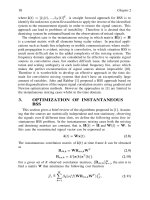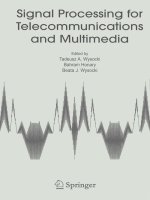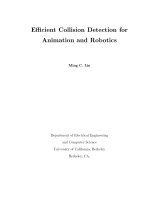Semi-blind signal detection for mimo and mimo-ofdm systems
Bạn đang xem bản rút gọn của tài liệu. Xem và tải ngay bản đầy đủ của tài liệu tại đây (526.47 KB, 103 trang )
SEMI-BLIND SIGNAL DETECTION FOR
MIMO AND MIMO-OFDM SYSTEMS
MA SHAODAN
Ph. D. THESIS
THE UNIVERSITY OF HONG KONG
2006
Abstract of thesis entitled
“Semi-Blind Signal Detection for MIMO and
MIMO-OFDM Systems”
Submitted by
Ma Shaodan
for the degree of Doctor of Philosophy
at The University of Hong Kong
in May 2006
MIMO (Multiple Input Multiple Output) and MIMO-OFDM (Orthogonal
Frequency Division Multiplexing) systems have attracted a lot of research interest in
recent years due to their potential for future high speed wireless communications.
This thesis focuses on the problem of signal detection and proposes three semi-blind
algorithms for MIMO, MIMO-OFDM with short cyclic prefix (CP), and MIMO-
OFDM without CP, respectively.
A three-step semi-blind Rake-based multi-user detection technique is proposed for
quasi-synchronous MIMO systems. The first step separates the multi-user multi-path
signal vector into multi-user single-path signal vectors based on second-order
statistics (SOS) of the received signals. A simple estimation method is proposed in the
second step to estimate the time delays with the aid of pilots. The third step combines
multiple multi-user single-path signal vectors for signal detection. System
performance is improved by time diversity and only the upper bounds of the channel
length and the time delays are required. Simulation results show that the proposed
technique achieves good performance and is not sensitive to over-estimation of the
maximum channel length and the maximum time delay.
A MIMO-OFDM system with short CP is next considered for higher bandwidth
efficiency and a time domain semi-blind signal detection algorithm is proposed. A
new system model in which the
i
th received OFDM symbol is left shifted by
J
samples is introduced. Based on some structural properties of the new system model,
an equalizer is designed using SOS of the received signals to cancel most of the inter-
symbol interference (ISI). The transmitted signals are then detected from the equalizer
output. In the proposed algorithm, only
2P
(
P
is the number of transmit
antennas/users in MIMO-OFDM systems) columns of the channel matrix need to be
estimated, and channel length estimation is unnecessary. In addition, the proposed
algorithm is applicable irrespective of whether the channel length is shorter than,
equal to or longer than the CP length. Simulation results verify the effectiveness of
the proposed algorithm, and show that it outperforms the existing ones in all cases.
Finally, in order to further improve bandwidth efficiency, a MIMO-OFDM system
without CP is considered and a two-step semi-blind signal detection algorithm is
proposed. The algorithm is based on some structural properties derived from shifting
the received OFDM symbols. The first step cancels inter-carrier interference (ICI) and
ISI with an equalizer designed using SOS of the shifted received OFDM symbols. The
second step involves signal detection from the equalizer output in which the signals
are still corrupted with multi-antenna interference (MAI). In the proposed algorithm,
precise knowledge of the channel length is unnecessary and only one pilot OFDM
symbol is utilized to estimate the required channel state information. Simulation
results show that the proposed algorithm achieves comparable performance to
algorithms for standard MIMO-OFDM systems and it is robust against channel length
overestimation.
The number of words: 460
Semi-Blind Signal Detection for MIMO and
MIMO-OFDM Systems
by
Ma Shaodan
B. Eng., M. Eng., Nankai University, P. R. China
A thesis submitted in partial fulfillment of the requirements for
the Degree of Doctor of Philosophy
at The University of Hong Kong
May 2006
i
Declaration
I declare that this thesis represents my own work, except where due acknowledgement is
made, and that it has not been previously included in a thesis, dissertation or report submitted
to this University or to any other institution for a degree, diploma or other qualifications.
Signed _________________________________
Ma Shaodan
ii
Acknowledgements
I would like to take this chance to express the deepest gratitude to my supervisor,
Professor T. S. Ng, for his continuous guidance and constructive suggestions during
the course of my Ph.D. program. I owe my gratitude to my dear husband, Mr. Yang
Guanghua, for his encouragement, support and helpful advices. I would like to thank
Dr. K. W. Yip, Dr. N. Wong and Dr. Yonghong Zeng for their helpful discussions and
valuable suggestions. I would also like to thank the members in my research group,
Dr. Zhou Yiqing, Mr. Chen Jianwu, Mr. Zheng gan, Mr. Ng ChiuWa, Mr. Wang
Hongzheng, Ms. Pan Xinyue, Ms. Peng Wei, for their friendship and useful
discussions. I would express my thanks to all the staff in the Department of Electrical
and Electronic Engineering for their supportive work. I also want to thank the
University of Hong Kong for the award of postgraduate studentship. It supports my
life in Hong Kong and makes me focus on my research. Finally, I owe my deepest
gratitude to my parents, for their trust and support all the time.
iii
Contents
Declaration ……………………………………………………………………….i
Acknowledgements………………………………………………………………ii
Table of Contents……………………………………………………………….iii
List of Figures…………………………………………………………………...vi
Abbreviations…………………………………………………………………..viii
Chapter 1
Introduction …………………………………………………...1
1.1 MIMO ………………………………………………………………..1
1.2 MIMO-OFDM ……………………………………………………….3
1.3 Semi-blind signal detection ………………………………………….4
1.4 Motivation and organization of the thesis …………………………...6
Chapter 2
Semi-Blind Rake-Based Multi-User Detection for Quasi-
Synchronous MIMO Systems ………………………………..9
2.1 Introduction ………………………………………………………….9
2.2 System model ………………………………………………………12
2.3 Semi-blind Rake-based multi-user detection technique ……………14
2.3.1 Multi-user single-path signal separation ………………….15
2.3.2 Time delay estimation …………………………………….17
2.3.3 Multi-path combining …………………………………….19
2.3.4 Channel noise consideration ……………………………...21
2.3.5 Performance analysis ……………………………………..22
iv
2.4 Examples and simulation results …………………………………...25
2.4.1 Time delay estimation …………………………………….25
2.4.2 Semi-blind Rake-based multi-user detection technique …..27
2.4.2.1 Example 1 ………………………………………….27
2.4.2.2 Example 2 ………………………………………….30
2.5 Summary ……………………………………………………………33
Chapter 3
Time Domain Semi-blind Signal Detection for MIMO-
OFDM Systems with Short Cyclic Prefix ………………….35
3.1
Introduction ………………………………………………………...35
3.2 System Model ……………………………………………………38
3.3 Time Domain Semi-Blind Signal Detection ……………………….41
3.3.1 Zero-noise case …………………………………………...43
3.3.1.1 Equalization and signal detection ………………….44
3.3.1.2
part
H
estimation ……………………………………47
3.3.1.3 Remark ………………………………………….....48
3.3.2
Channel noise consideration ……………………………..49
3.3.3 Computational complexity ……………………………….50
3.4 Simulation results ………………………………………………….51
3.4.1 The case where the channel length is shorter than or equal to
the CP length:
L D≤
……………………………………………52
3.4.2 The case where the channel length is longer than the CP
length:
L D>
……………………………………………………54
3.4.3 Comparison ……………………………………………….56
3.4.4 Data length effect …………………………………………57
3.5 Summary ……………………………………………………………58
v
Chapter 4
Two-Step Semi-Blind Signal Detection for MIMO-OFDM
Systems without Cyclic Prefix ……………………………...60
4.1 Introduction ………………………………………………………..60
4.2 System Model ………………………………………………………62
4.3 Two-Step Semi-blind Signal Detection ……………………………66
4.3.1 Blind ICI and ISI cancellation ……………………………67
4.3.2 Signal detection in the presence of MAI ………………….70
4.3.3 Effect of channel noise ……………………………………71
4.3.4 Implementation …………………………………………..72
4.4 Simulation Results …………………………………………………73
4.4.1 Effect of
SNR
………………………………………….…73
4.4.2 Effect of the parameter
K
………………………………..76
4.4.3 Effect of channel length overestimation ………………….78
4.5 Summary ……………………………………………………………79
Chapter 5
Conclusions and suggestions for future research …………80
Reference ……………………………………………………83
Publications ………………………………………………….89
vi
List of Figures
1.1 MIMO system ………………………………………………….2
1.2 MIMO-OFDM system …………………………………………...4
1.3 Semi-blind technique …………………………………………….6
2.1 Quasi-synchronous transmission scheme ……………………….12
2.2 Block diagram of semi-blind Rake-based multi-user detection
technique ……………………………………………………….15
2.3 Rake-based receiver …………………………………………….20
2.4 Time delay estimation (
1
d
= 2,
2
d
=4 and
3
d
=1) ………………26
2.5 BER versus SNR (synchronous MIMO system) ………………..29
2.6 BER versus the estimated maximum channel length
ˆ
L
(SNR =
18dB; synchronous MIMO systems) ……………………………30
2.7
BER versus SNR (quasi-synchronous MIMO system) …………31
2.8
BER versus the estimated maximum channel length
ˆ
L
(SNR =
20dB; quasi-synchronous MIMO systems) ……………………..32
2.9
BER versus the estimated maximum delay
ˆ
PU
d
(SNR = 20dB;
quasi-synchronous MIMO system) …………………………….33
3.1
Block diagram of time domain signal detection algorithm for
MIMO-OFDM system with short CP …………………………...42
vii
3.2
The case where the channel length is 14 (
14
L
=
) ……………..53
3.3
The case where the channel length is 16 ( 16L
=
) ……………..54
3.4
The case where the channel length is 18 ( 18L
=
) .…………...55
3.5
The case where the channel length is 20 ( 20L
=
) …………….56
3.6
Proposed algorithm for L=14, 16, 18, 20 ( 16D
=
) …….……...57
3.7
Data length effect on the proposed algorithm ( 20L
=
and
20SNR dB
=
)…………………………………………………….58
4.1
Block diagram of MIMO-OFDM-WCP system …………………62
4.2
Block diagram of the receiver structure …………………………67
4.3
BER versus SNR when the channel length is 6 ( 6L
=
) ..………..75
4.4
BER versus SNR when the channel length is 8 ( 8L
=
) .………...76
4.5
Effect of
K
when the channel length is 6 ( 6L
=
) …..…………..77
4.6
Effect of
K
when the channel length is 8 ( 8L
=
) .……………..78
viii
List of Abbreviations
FDMA Frequency Division Multiple Access
TDMA Time Division Multiple Access
CDMA Code Division Multiple Access
SDMA Spatial Division Multiple Access
MIMO Multiple Input Multiple Output
HSDPA
High Speed Downlink Packet Access
OFDM Orthogonal Frequency Division Multiplexing
OFDMA Orthogonal Frequency Division Multiple Access
DAB Digital Audio Broadcasting
DVB Digital Video Broadcasting
WLAN Wireless Local Area Network
GSM Global System of Mobile communication
HOS Higher Order Statistics
SOS Second Order Statistics
MAI Multiple Antenna Interference
ISI Inter-Symbol Interference
ICI Inter-Carrier Interference
i.i.d independently identically distributed
BER Bit Error Rate
SNR Signal-to-Noise Ratio
ix
LS Least Squares
MMSE Minimum Mean Square Error
QPSK Quadrature Phase Shift Keying
QoS Quality of Service
AWGN Additive White Gaussian Noise
CP Cyclic Prefix
1
Chapter 1
Introduction
With the growth of broadband internet access and the development of multimedia
services in cellular mobile wireless communications, an ever-increasing demand for
high capacity and high speed transmission with good Quality-of-Service (QOS) has
been created. To meet this demand, various techniques have been proposed.
1.1 MIMO
In the 1
st
generation (1G) mobile communication system, frequency domain is
exploited to achieve the desired system capacity by FDM (Frequency Division
Multiplexing), while time domain is exploited by TDM (Time Division Multiplexing)
in the 2
nd
generation (2G) mobile communication system. To improve the system
capacity, code domain is exploited by CDM (Code Division Multiplexing) in some
2G and current 3
rd
generation (3G) mobile communication systems. However, the
data rate which can be achieved in the current and extended 3G systems is only as
high as 14.4Mbps.
To further improve the system capacity, space domain, which is regarded as the
"last frontier" that can substantially improve the capacity, is exploited in the 3.5G
such as HSDPA (High Speed Downlink Packet Access) system and being considered
for the next generation mobile communication systems. As a capacity boosting
2
technique, MIMO (Multiple Input Multiple Output) utilizes multiple antennas at both
ends of a wireless link as shown in Fig. 1.1. A number of signals are simultaneously
transmitted from different transmit antennas onto the same physical channel and then
separated by multiple receive antennas and signal processing techniques at the
receiver. Independent studies have shown that the capacity of MIMO systems can
grow linearly with the number of transmit and receive antennas [Winters, Salz and
Gitlin, 1994; Foschini and Gans, 1998; Paulraj, Gore, Nabar and Bolcskei, 2004]. A
lot of research interest has thus been attracted to MIMO systems due to their high
capacity and spectral efficiency in recent years [Dai, Molisch and Poor, 2004; Chizhik,
Ling, Wolniansky, Valenzuela, Costa and Huber, 2003; Chizhik, Foschini, Gans and
Valenzuela, 2002].
Fig. 1.1 MIMO system
Generally, MIMO systems can be classified into two categories. One is space time
coding system where correlated data streams are transmitted through different
antennas and the transmission quality (bit-error-rate) is improved due to spatial
diversity [Tarokh, Seshadri and Calderbank, 1998]. The other is spatial multiplexing
RX M
RX 1
TX P
TX 2
TX 1
Data
stream
Space
Time
Coding
or
Spatial
Demux
Receiver
Frequency
selective
fading
channels
3
system where independent data streams are transmitted over different antennas, thus
increasing the transmission rate or improving the system capacity [Gesbert, Shafi,
Shiu, Smith and Naguib, 2003]. In this thesis, the focus is on spatial multiplexing as
the goal is to increase the data transmission rate.
1.2 MIMO-OFDM
OFDM (Orthogonal Frequency Division Multiplexing) was first proposed by Chang
[1966]. The basic operational principle is that the high-rate data stream is split and
modulated into a number of parallel orthogonal subcarriers using a bank of sinusoidal
generators. In 1971, Weinstein and Ebert [1971] suggested the employment of
discrete Fourier transform (DFT) to replace the bank of sinusoidal generators and
demodulators, which significantly reduces the implementation complexity of OFDM.
Afterwards, a lot of studies on OFDM were presented, e.g., [Cimini, 1985; Hirosaki,
1981; Kalet, 1989; Hirosaki, 1980; Muquet, Wang, Giannakis, de Courville and
Duhamel, 2002; Speth, Fechtel, Fock and Meyr, 1999; Muquet, de Courville and
Duhamel, 2002; Heath, and Giannakis, 1999; Lei and Ng, 2004; Luise, Reggiannini
and Vitetta, 1998].
As a special case of multi-carrier modulation, OFDM has high spectral efficiency
and is robust against frequency selective fading which is accomplished by inserting a
cyclic prefix at the beginning of each OFDM symbol. The high spectral efficiency and
robustness have justified the adoption of OFDM as a standard transmission technique
in a host of applications such as satellite and terrestrial digital audio broadcasting
(DAB), digital video broadcasting (DVB) and wireless local area network (WLAN,
e.g. IEEE 802.11a/g).
As mentioned before, MIMO is a promising system to achieve high system
capacity for multimedia applications in wireless communications. In practice,
multipath propagation usually occurs and causes frequency selective fading in MIMO
channels. It is therefore desirable to combine MIMO with OFDM technique as
4
illustrated in Fig. 1.2 to combat the effect of frequency selective fading. Currently,
MIMO-OFDM technique with high system capacity as well as robustness against
frequency selective fading is attracting considerable research interests all over the
world [Sampath, Talwar, Tellado, Erceg and Paulraj, 2002; Stuber, Barry, Mclaughlin,
Li, Ingram and Pratt, 2004; Bolcskei, Gesbert and Paulraj, 2002; Bolcskei, Borgmann
and Paulraj, 2003; Dubuc, Starks, Creasy and Hou, 2004]. It is being adopted in the
coming WLAN standard (IEEE 802.11n) and is recognized as a strong candidate for
the future 4
th
generation (4G) mobile communications standards.
Fig. 1.2 MIMO-OFDM system
1.3 Semi-blind signal detection
Traditional signal detection techniques use training sequences to estimate the channel
as the first step. Signal detection then follows equalization. Most mobile
communication standards such as GSM (Global System of Mobile communication)
include training sequence to estimate the channels. These techniques are robust and
yield accurate channel estimation but the bandwidth efficiency is inevitably reduced.
For example, in GSM, 20% of the bits in a burst are used as training sequences.
RX M
RX 1
TX P
TX 2
TX 1
Data
Spatial
Demux
IDFT
IDFT
Receiver
Frequency
selective
fading
channels
CP
insertion
IDFT
CP
insertion
CP
insertion
5
To eliminate this bandwidth efficiency reduction when the wireless system is
operating on slow fading channels, blind signal detection techniques based on only
the received signals without any training sequence are proposed in [Inouye and
Hirano, 1997; Tugnait, 1997; Thirion-Moreau and Moreau, 2002; Tugnait, 1998;
Giannakis, Inouye and Mendel, 1989; Shen and Ding, 2000; Zhu, Ding and Cao, 1999;
Tugnait and Huang, 2000; Tugnait, 1998; Abed-Meraim and Hua, 1997; Abed-
Meraim, Loubaton and Moulines, 1997; Xavier, Barroso and Moura, 2001]. Generally,
blind techniques are based on the higher-order statistics (HOS) or the second-order
statistics (SOS) of the received signal. SOS methods are particularly attractive since
they have lower computation complexity and require shorter data records to
accurately estimate the statistics. However, the SOS methods suffer from the lack of
robustness: many blind SOS methods fail when the channel length is overestimated.
In addition, the SOS methods usually leave an indeterminacy in the symbols. This
suggests that the SOS methods should not be utilized alone. It requires some form of
additional information.
To overcome the above problem, semi-blind techniques are proposed [Zeng and
Ng, 2004] as shown in Fig. 1.3. It exploits the information used by blind methods as
well as the information coming from known symbols. As it incorporates the
information of known symbols, the possible pitfalls of blind methods are avoided. On
the other hand, exploiting the blind information in addition to the known symbols
allows the detection of the signals with the use of shorter training sequence for a
desired detection quality. Apart from the robustness consideration, semi-blind
techniques also appear very interesting from a performance point of view, as it can
offer better performance than the training sequence methods or the blind methods
when the wireless system is operating on slow fading channels.
6
Fig. 1.3 Semi-blind technique
1.4 Motivation and organization of the thesis
In MIMO and MIMO-OFDM systems, a number of signals from multiple antennas
are transmitted through multi-path channels. They may suffer from a deep fading and
be corrupted by interference and noise at the receiver. Signal detection is therefore an
important component in these systems.
Most of the works done on signal detection for MIMO systems consider
synchronous case. It means that all signals transmitted from different users must be
time-aligned at the receiver. Perfect synchronization among all users is thus required.
However, when applying MIMO to the uplink of a cellular mobile communication
system, it is generally difficult to achieve perfect synchronization due to different
locations of mobiles and multi-path propagations. A quasi-synchronous MIMO
system operating in multi-path channels, in which signals of all users are time-aligned
at the receiver to within a synchronization window, is more consistent with real
situations as different users are likely to have slightly different time delays. However,
there are few signal detection algorithms, if any, proposed for quasi-synchronous
MIMO systems due to the difficulties in time delay estimation and intersymbol
interference cancellation.
As a promising candidate for the future 4G mobile communication standards,
MIMO-OFDM has high system capacity and is robust against frequency selective
fading. However, in most of the works for MIMO-OFDM system, a cyclic prefix is
required at the beginning of each OFDM symbol [Sampath, Talwar, Tellado, Erceg
Training sequence
methods
Blind methods
Training sequence
All symbols are considered as unknown
Combines training sequence and blind information
Semi-blind methods
7
and Paulraj, 2002; Stuber, Barry, Mclaughlin, Li, Ingram and Pratt, 2004; Bolcskei,
Gesbert and Paulraj, 2002; Bolcskei, Borgmann and Paulraj, 2003; van Zelst and
Schenk, 2004]. The length of the CP is chosen longer than the channel length to
eliminate the inter-carrier interference (ICI) and inter-symbol interference (ISI). For
example, in the wireless local area network (IEEE 802.11a) standard, the length of CP
is 25% of an OFDM symbol duration, resulting in a significant loss in bandwidth
efficiency. It is apparent that if the CP is shortened or removed, substantial gain in
bandwidth efficiency can be achieved. A MIMO-OFDM system with short CP or
without CP is therefore desirable. As the CP is shortened or removed, ICI and ISI may
be introduced in the received signals. Their presence destroys the orthogonal property
of the subcarriers, making signal detection very difficult. So far, only few published
works are available in the literature.
Motivated by practical situation in mobile communication systems and for higher
bandwidth efficiency, this thesis addresses the signal detection problem for three
systems in the following three chapters. In Chapter 2, a quasi-synchronous MIMO
system is considered and a semi-blind Rake-based multi-user detection technique is
proposed. It consists of three steps: multi-user single-path signal separation, time
delay estimation and multi-path combination. It is proved that better BER
performance is achieved by time diversity and the proposed technique is not sensitive
to over-estimation of the maximum channel length and the maximum time delay. In
Chapter 3, a MIMO-OFDM system with short CP is considered for higher bandwidth
efficiency and a time domain semi-blind signal detection algorithm is proposed. An
equalizer is designed using SOS of the received signals to cancel most of the ISI. The
transmitted signals are then detected from the equalizer output. The proposed
algorithm has its own advantages as compared to the existing ones and its
effectiveness is verified by computer simulation. In Chapter 4, a MIMO-OFDM
system without CP is considered to further improve the bandwidth efficiency and a
two-step semi-blind signal detection algorithm is proposed. The first step cancels ICI
and ISI with an equalizer. The second step is signal detection from the equalizer
8
output in which the signals are still corrupted with multi-antenna interference (MAI).
In the proposed algorithm, precise knowledge of the channel length is unnecessary
and only one pilot OFDM symbol is utilized. By computer simulations, it is shown
that the proposed algorithm achieves comparable performance to algorithms for
standard MIMO-OFDM systems and it is robust against channel length
overestimation. Finally, the thesis is concluded in Chapter 5.
9
Chapter 2
Semi-Blind Rake-Based Multi-User
Detection for Quasi-Synchronous
MIMO Systems
2.1 Introduction
As introduced in Chapter 1, when applying MIMO to the uplink of a cellular mobile
communication system, perfect synchronization among all users is generally difficult
to achieve due to different locations of mobiles and multi-path propagations. It is
therefore more reasonable to model the system under consideration as a quasi-
synchronous MIMO system where different users are likely to have slightly different
time delays. However, there are few algorithms, if any, proposed for quasi-
synchronous MIMO systems due to the difficulties in time delay estimation and
intersymbol interference cancellation.
In wireless communications, multi-path signals have been exploited to achieve
diversity gain to improve the system performance. Rake receiver technique is widely
used in CDMA systems for single-user detection as multi-path signals transmitted
from a desired user can be easily separated from other users utilizing the orthogonal
property of spreading codes between different users and the low cross correlation
property of the desired user’s spreading code [Bottomley, Ottosson and Wang, 2000;
10
Tjhung, Xue, Dai, Wong and He, 2002; Singh, Kumari, Mallik and Jamuar, 2002;
Mallik, Singh and Kumari, 2003; Liu and Li, 1999]. It is not used in TDMA and
FDMA as signal detection is relatively simple and the performance gain cannot be
justified by the added complexity. MIMO with spatial multiple access is analogous to
CDMA in the sense that multiple users transmit simultaneously into the same physical
channel. The fact that Rake receiver has not been utilized in MIMO so far can be
attributed to the difficulty in multi-user detection which requires separating multi-user
multi-path signals as well as estimating the time delay for each user.
In this chapter, a semi-blind Rake-based multi-user detection technique which
incorporates a new simple time delay estimation method is proposed for quasi-
synchronous MIMO systems operating in multi-path channels. The proposed
technique consists of three steps. The first step separates the multi-user multi-path
signal vector into multi-user single-path signal vectors based on second order
statistics (SOS) of the received signals without knowledge of the channel state
information. The second step is time delay estimation which is essential for signal
detection. The third step combines multiple multi-user single-path signals and detects
the multi-user signals.
The first step in the proposed technique is to model the received signals of all
users as synchronous so that many of the existing signal detection algorithms [Zhu,
Ding and Cao, 1999; Lopez-Valcarce and Dasgupta, 2001; Moulines, Duhamel,
Cardoso and Mayrargue, 1995; Tugnait, 2001; Miller, Taylor and Gough, 2001;
Abed-Meraim, Loubaton and Moulines, 1997; Liu and Xu, 1997; Hua, An and Xiang,
2003] for synchronous MIMO systems can be used to separate the users’ signals into
multi-user single-path signals. Unlike CDMA systems where the orthogonal property
of spreading codes is utilized to separate multi-path signals, SOS of the received
signals is generally utilized to separate the multi-path signals in MIMO systems. One
SOS-based method, the column-anchored zeroforcing method [Zhu, Ding and Cao,
1999], is chosen in the proposed technique as it is not sensitive to channel length
overestimation so that perfect channel length estimation is not required. For the
11
second step, as the time delay information of all users are embedded in each of the
multi-user single-path signal vector after step one, the strongest signal vector is
selected for time delay estimation. To the best of the authors' knowledge, only two
pilot-based time delay estimation methods have been proposed [Nishimura, Tanabe,
Ohgane, Ogawa, Doi and Kitakado, 2000]. The first one uses the sliding correlator,
which has the limitation that when the difference between any two delays is less than
two symbol periods, accurate estimation cannot be achieved. The second one is the
vector orthogonalization method, which is computationally complex as it requires
estimating the noise subspace of the received-signal matrix. Since the time delay
information can be modeled in either the user signal vector or the channel matrix, a
simple pilot-based method is proposed for the latter model using the structural
properties of the channel matrix. It is relatively simple compared with the methods in
[Nishimura, Tanabe, Ohgane, Ogawa, Doi and Kitakado, 2000] and it also has the
added advantage that it does not require the actual maximum time delay. Only the
upper bound is needed.
Once the time delays for different users have been estimated, the different path
signals are combined using the Rake receiver principle for multi-user detection. It is
shown that the output of the combiner yields the estimated transmitted signals. It
follows that the multi-user signals can easily be detected after the time delays are
estimated. The advantages of the proposed technique are: 1) perfect synchronization
of all users is not required; 2) time diversity is achieved by Rake-based receiver for
performance enhancement; 3) only the upper bounds of the channel length and the
time delay are needed. Simulation results show that the proposed technique achieves
good performance and is robust against over-estimation of both the maximum channel
length and the maximum time delay. These results indicate that the proposed
technique can readily be implemented because perfect estimation of the maximum
channel length and the maximum time delay, tasks that are difficult in practice, are
not required.
The rest of this chapter is organized as follows. In Section 2.2, the quasi-
12
synchronous MIMO system model is introduced. The semi-blind Rake-based multi-
user detection technique with time delay estimation is presented in Section 2.3. In
Section 2.4, the performance of the proposed technique is demonstrated by simulation.
Finally, a summary of this chapter is given in Section 2.5.
2.2 System model
A MIMO system with
P
users sharing the same physical channel, each transmitting a
signal via a single antenna to the receiver having
M
receive antennas, is considered.
The communication channel for each user is a multi-path fading channel. This
situation arises in the uplink of a mobile communication system in which a mobile
station is usually equipped with one antenna and multi-path propagation usually
occurs. The channel between the transmit antenna of the i th user and the j th receive
antenna at the receiver, denoted by
()
ij
hn, is modeled as an
ij
L th-order FIR filter. In
quasi-synchronous systems, the signals of all users are time-aligned at the receiver
within a small synchronization window as shown in Fig. 2.1.
Fig. 2.1. Quasi-synchronous transmission scheme.
time
Synchronization window
PU
d
2
d
1
d
User
P
Transmitted signal
Transmitted signal
Transmitted signal
User 1
User 2
P
d









